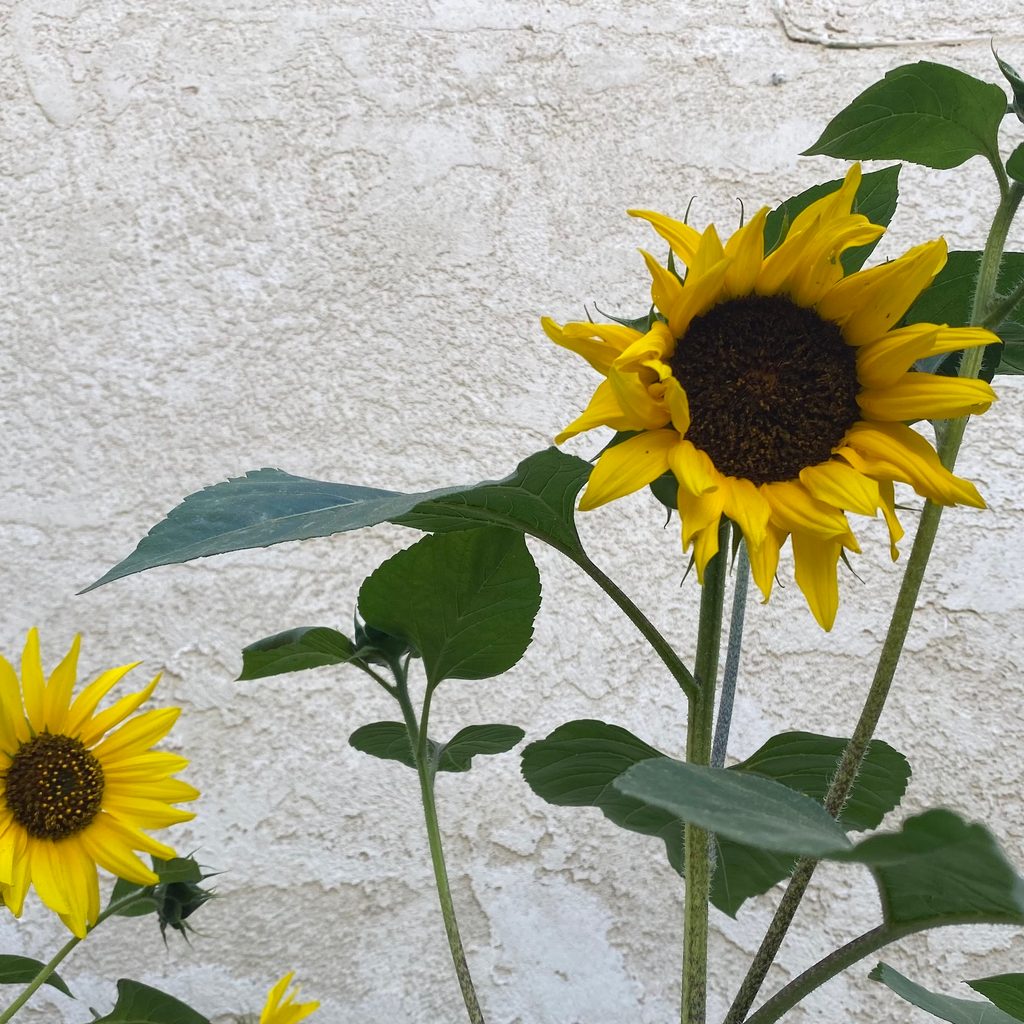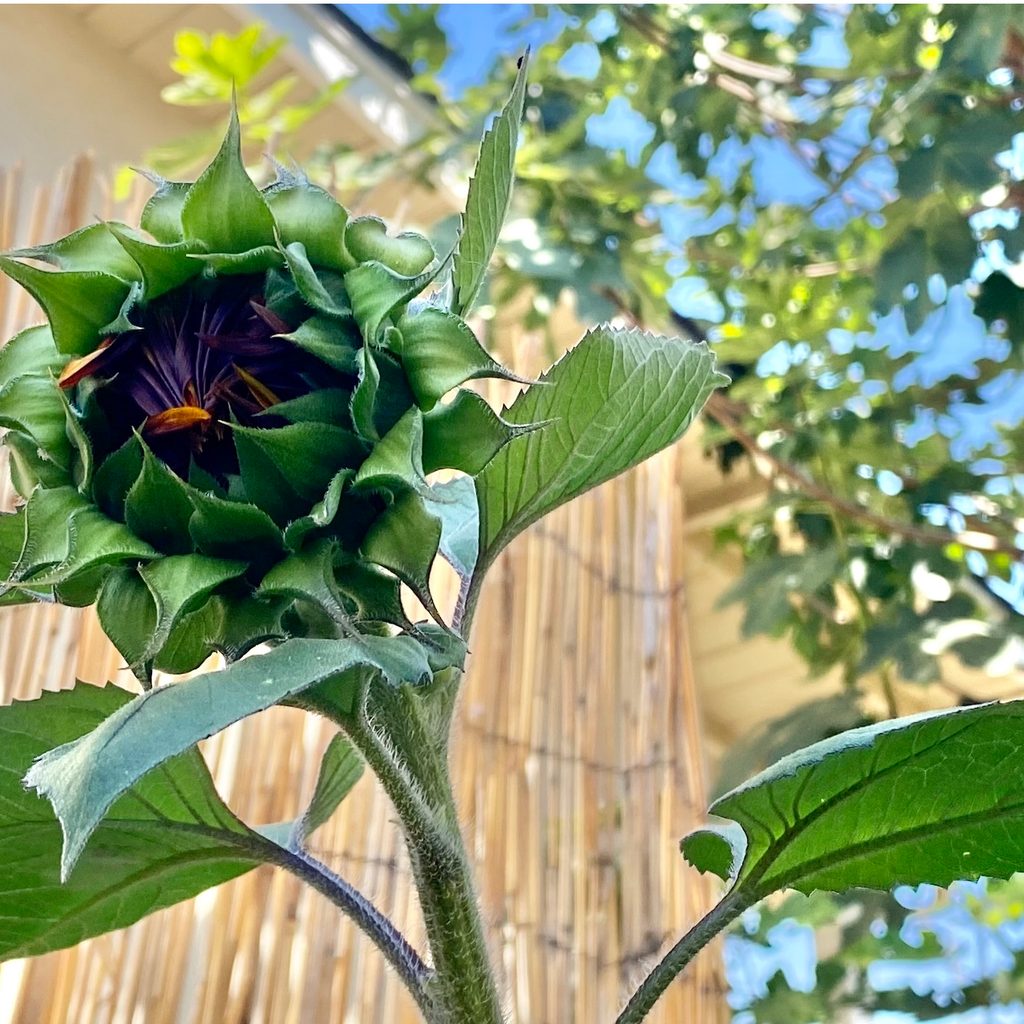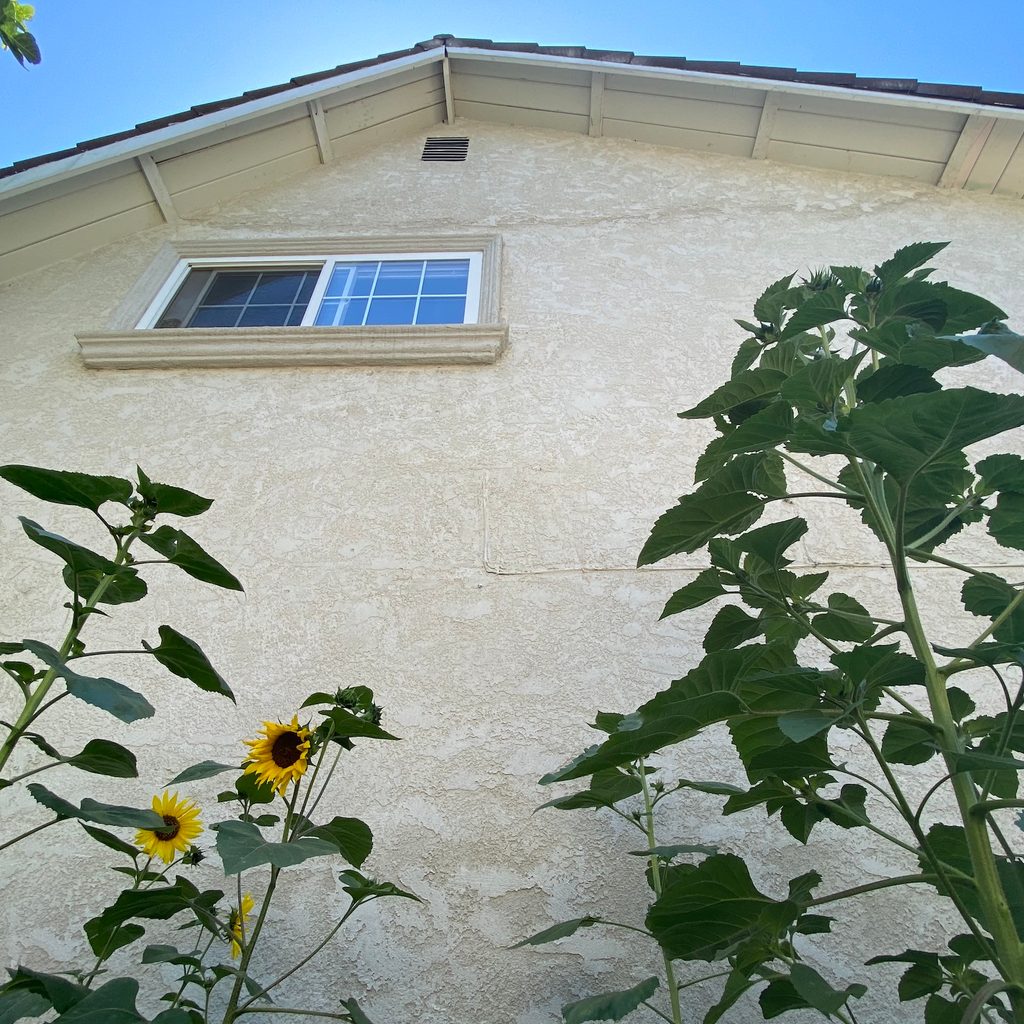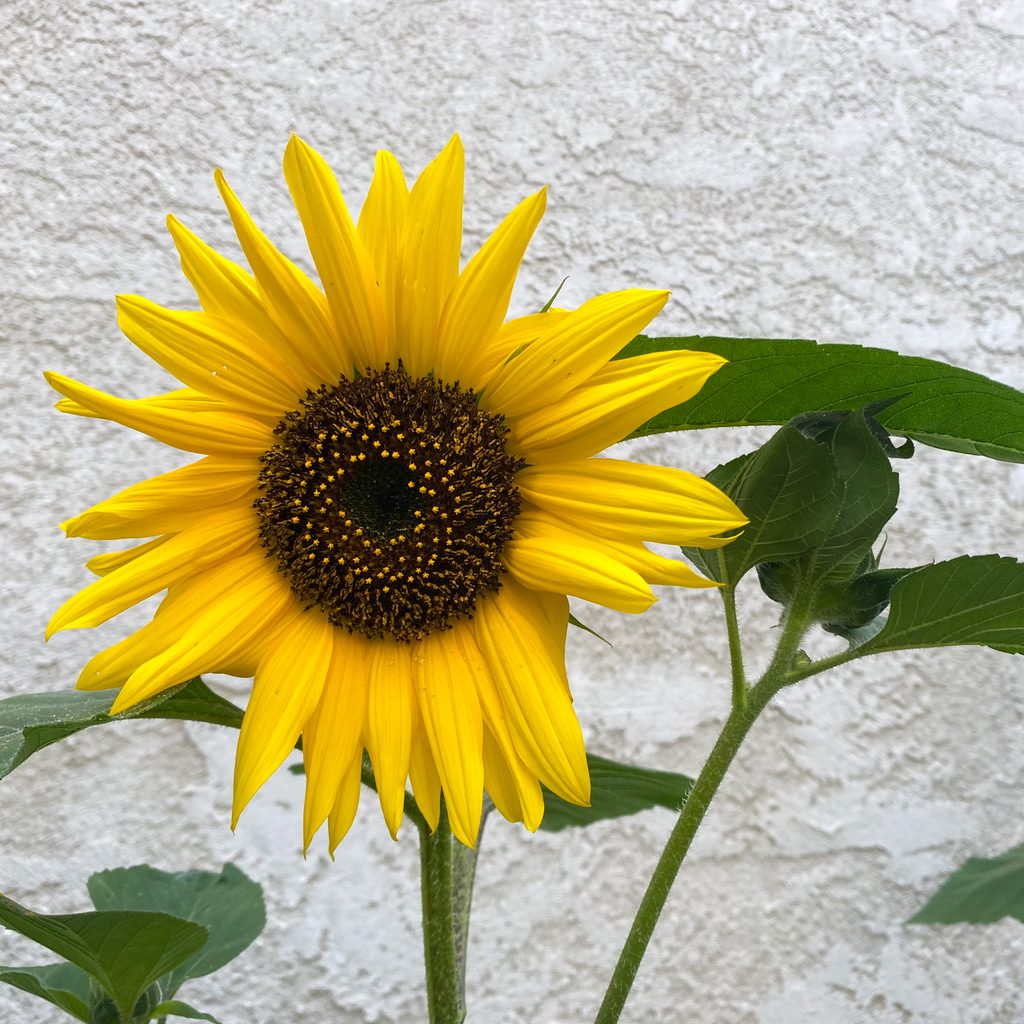Nothing in nature fully encompasses the warmth and cheerfulness of summer and fall like the sunflower. With warm weather blooms ranging from the lightest yellow to the deepest red and even chocolate brown, they add an element of awe to nearly any garden space—an element that I’ve been attempting to replicate in my own garden for years. Every spring, another new obstacle got in my way. That is—until now.
This summer, my side yard is lined with 6 to 10-foot-tall sunflowers. I’ve enjoyed a number of bright yellow blooms in the last few weeks, though the fiery show is far from over. For every bud that’s bloomed so far, there are at least three more that haven’t yet. So what did I do differently this year?
To help us learn how to grow sunflowers, I spoke with Teagan Lee Milera, a sixth generation farmer at Lee Farms, which her family owns and operates. She and her sister Kara even run Oregon’s largest Sunflower Festival, which takes place every August—so she knows her way around a sunflower field. I’m here to provide a backyard-friendly point of view, so you’re sure to get all the info and ideas for growing your own giant-sized sunflowers at home. Let’s dive in!

Why plant sunflowers?
Who doesn’t love the bright, cheerful sight of a sunflower in full bloom? These beauties come in a variety of colors and types to keep your garden vibrant, while their familiar yellow profile isn’t hard to find when seed shopping in the spring or fall. Apart from their popularity in floral arrangements, garden beds, and even pumpkin patches, why are sunflowers grown?
Agriculturally speaking, sunflowers are grown for a variety of purposes, from the production of food items to the enrichment of the soil they grow in. For the sisters at Lee Farms, sunflowers are the star of “agritainment” (or “agriculture entertainment”) on the Oregon property. They are, in the words of Lee Milera, “for visitor experience and enjoyment.”
“We dedicate approximately five acres to growing sunflowers for the pure purpose of entertaining visitors,” she says. “Once our festival wraps up, we mow down the sunflower stems and leftover flower heads and seeds and feed them to our cattle. Sunflowers are an excellent source of fat and protein.”
Sunflower seeds are certainly a popular snack—and a great addition to any salad—while the oil they produce serves as a trendy alternative to vegetable or olive oil. Sunflower oil can be used as an ingredient in dressings or as nut butter substitutes. It can also be used on its own for frying, sautéing, or searing a number of delicious foods. Cattle aren’t the only ones who enjoy a good sunflower snack.
In 2017, researchers from the University of California Division of Agriculture and Natural Resources dove into studying the long-term benefits of sunflower crops on the soil and surrounding environment. They found that sunflowers improve soil condition by breaking it up with their strong taproot system, introducing beneficial fungi and bacteria to the existing nutrients and adding more organic biomass to the soil.
As it turns out, sunflowers also contain substances that are toxic to other plants (don’t worry—it’s not harmful to people or animals). Grass, potatoes, and even weeds may have a harder time growing near these flowers, which could be either an advantage or disadvantage in your home garden.

Why didn’t my sunflowers grow?
Since I was a child, I’ve been enchanted by sunflowers. Every spring I would purchase seeds and start them in the backyard, only to be swallowed up by disappointment when they never made it far past the seedling stage. What was I doing wrong?
My biggest mistakes were a lack of pest control (I wasn’t an experienced gardener at the ripe old age of 12) and not starting my seeds outdoors. Though sunflowers can absolutely be started indoors, especially when there’s still risk of frost, this makes the growing process unnecessarily complex. When planted directly in the soil, sunflowers are hardy and forgiving plants. Lee Milera explains that “you can have pretty poor soil quality and throw some sunflower seeds down and they will very likely grow. Anyone can grow them!”
That being said, there are a few things you should know before planting sunflower seeds in your garden, especially if you want to grow the tallest, most healthy plants.

How to plant sunflowers in your backyard
Though sunflowers are famously low-maintenance when grown in the right settings, reading up about the Helianthus (the sunflower’s Latin moniker) and their basic needs can give you a jump start on the path to a lush garden.
How much space does a sunflower plant need?
When it comes to sunflowers, according to the sisters at Lee Farms, space and soil requirements are minimal. As Teagan Lee Milera said, you can practically toss down some seeds and wait for them to grow! In fact, it’s not uncommon for sunflowers to plant themselves: they’ll often sprout beneath bird feeders since small sunflower seeds are a popular ingredient in birdseed.
For the ideal conditions, however, your garden soil should be warm with at least average drainage. The seeding pros at Burpee admit that young sunflowers can survive a frost or two, especially in locations where the growing season is shorter—but this doesn’t mean they should. If you can, wait until your soil temperatures are at least 65 degrees. In places like California’s Sacramento Valley and high desert, you can likely grow sunflowers year-round, though locales such as New England will have to stick closer to a traditional spring-fall schedule.
When I planted what would become this summer’s dreamlike sunflower forest—I planted these seeds in late spring—I followed the directions on the seed packet to a T. I sowed each seed about 8 inches apart in a checkerboard pattern (rows are the most popular, and easiest technique) and covered each with an inch of soil.
Though Lee Milera is right in saying sunflowers don’t need a lot of space to start growing, their roots may spread out further from the stalk than you expect. My fully grown sunflowers are spaced at least two feet apart, which required some thinning as they grew—but more on that later.
How much water does a sunflower plant need?
Sunflowers are forgiving and drought-tolerant, which makes them a great addition to any yard in the dry American West. They originated in the plains—which tend to be dry—from as far north as Canada to as far south as Mexico, though they can withstand hardiness zones 2-11 (via Missouri Botanical Garden).
With sunflowers, overwatering can be more harmful to the plant than under-watering. Pooling of water can lead to root rot, even when sunflowers are fully grown; though their specific water needs change a bit depending on their stage of growth, more water should be given when they’re first planted. You can reduce this to once or twice a week once the plants are established. According to SF Gate, infrequent but deep watering is ideal to encourage deep root growth, though more water can be given in the 20 days before and after flowering for healthy blooms.
When watering, ensure that several inches of the soil is soaked through. This may take several gallons for more than one plant. One way to ensure proper watering is to use sunflower breeder Dr. Tom Heaton’s prize-winning technique: dig a moat around each sunflower—about 18 inches in diameter and 4 inches deep. When you water your plant, water directly into this moat to ensure the roots are hydrated.
Try to water your sunflowers in the morning or evening, when they can soak up the most water without sunlight evaporating it. Keep an eye on your sunflowers to gauge whether you’re giving them the appropriate amount of water. Wilting leaves and flowers is a good indicator of under-watering, while overwatering may result in yellowing or browning leaves in addition to wilting.
How much light does a sunflower plant need?
These plants are named “sunflowers” for a reason: they love the light. These beauties do best in full sun, which is any spot that gets six or more hours of direct sunlight per day. This isn’t to say that Helianthus can’t grow in partial shade, though the ones that do tend to produce fewer and smaller blooms. Plants residing in the shade may not need as much water, either.
Location is key to guaranteeing enough sunlight for your flowers. Once you find the perfect spot, though, Mother Nature will do the rest for you.
Pest control for sunflowers
When I grew sunflowers in past years, I wasn’t prepared to protect them from birds and insects who love them just as much as I do. Any seedlings that survived transplanting were quickly gobbled up by hungry caterpillars or completely torn out of the soil by birds. It was strangely relieving to hear that even Lee Farms has trouble controlling pests on their sunflowers. Luckily, Lee Milera was generous enough to share their strategy:
“We release ladybugs every summer into the fields which have a small but worthy impact,” she explains. “If we notice a huge infestation of sunflower beetles or Japanese beetles then we might dust some Sevin pesticide powder on that area of the field. Typically, we don’t use pesticides.”
Sevin is a popular name-brand insecticide that’s available at most home improvement and garden stores. Its main ingredient—carabyl—is EPA-approved for safe use on garden plants, fruits, and vegetables, though it should still be used with extreme caution.
A homemade alternative for caterpillar dissuasion is a chili powder/water mix, which I used this year at the first sign of insect damage to my seedlings. Some plants can be hurt by chili powder, so it’s always smart to give this strategy a test before going all out.
“Another trick we use,” reveals Lee Milera, “is to roll the rows with a tractor implement after planting the seeds so that birds can’t see the exact line of rows, which helps eliminate birds and squirrels from eating the seeds before they germinate.”
Luckily, the Lee Farms sunflower field is large enough that pests usually don’t pose a significant problem. For those of us without tractors at home, hanging shiny or reflective objects nearby, like reflective pinwheels, is another method to use.
Weed control for sunflowers
Weed control is the biggest obstacle that both Teagan Lee Milera and her family have faced on their five-acre sunflower patch. “We use a lot of compost in our fields and with the rich compost material, also comes a TON of weeds!” So what can be done to help?
“After we plant our sunflower seeds, we use a pre-emergent element,” she explains. “This helps with some weed control; however, we use such a mild form (Prowl at a very low rate) that we still have many weeds to control.” Prowl is a water-based pendimethalin herbicide that helps with weed control, though it contains the same ingredients as the well-known brand, Preen.
Herbicides certainly aren’t the only way to control the presence of weeds. “We then start pulling weeds by hand,” says Lee Milera, “and cultivating with a tractor in between the rows to uproot weeds. We sometimes even mow in between the rows.”
When in doubt, some backbreaking weed pulling gets the job done. This year, I pulled every sprout by hand and never felt overwhelmed as long as I weeded regularly. You don’t necessarily need fancy equipment to keep your sunflowers pest-free, though it certainly makes it more convenient.
How to help sunflowers grow tall
Dr. Tom Heaton, sunflower breeder extraordinaire, writes that the tallest, most impressive sunflowers won’t be found in a pot. That’s not to say they won’t grow, but with a deep root system needed to anchor them, sunflowers in pots will be very limited in size. Instead, try planting them directly in the ground whenever you’re ready.
As Teagan Lee Milera shared, Lee Farms uses compost in the soil to help enrich plants from the very beginning of their life cycles. In addition to being environmentally friendly, composting is a great way to add nutrients and structure to your soil—and the plants that call it home.
As your sunflowers grow, you might need to provide them with some extra stability. Tall plants with surface-level roots are especially sensitive to wind, which means that drier sunflowers are more likely to need a little help. A simple garden stake will do just fine, though you may need to upgrade as your sunflower gains height.
If you plant multiple seeds in one location or notice your sunflowers are growing close together, you may have to do some careful thinning. This can be a hard thing for a plant parent to do, but it’s necessary for the healthy growth of most plants.
When your seedlings develop their first true leaves, thin them until plants are spaced 1 to 2 feet apart, depending on the expected (and desired) size of the mature plant. Many larger varieties can grow closer together but will mature with much smaller buds. Branching varieties of sunflower will love having more space to themselves, so it’s best to know what you’re planting.

What to do with your sunflower
As your sunflowers bloom, you’re faced with many choices—just what should you do with your stunning new foliage? Helianthus makes the perfect addition to any floral arrangement, or even displayed on their own. For tips on cutting and displaying your sunflowers, as well as drying and harvesting the seeds, check out this helpful webpage from Lee Farms’ annual Oregon Sunflower Festival.
Though many factors ultimately affect a plant’s success, growing sunflowers in the right conditions can be as easy as pie. It’s all about knowing what to look for in your technique, your timing, and—of course—your environment. With any luck and a bit of hard work, your yard will be brimming with luscious summertime and autumn blooms—all thanks to you.
For sunflower enthusiasts in the western United States, the Oregon Sunflower Festival is the place to be. Lee Farms opens their farm and field to the public every weekend in August (including Fridays) from 10 a.m. to 6 p.m. purely for the celebration of these sunny blooms.
Every ticket, which should be purchased in advance to reduce crowding, includes one U-Pick bloom from the sunflower field, a scenic hayride out to a sunflower maze, and access to live music, food, and beverages, as well as over 120 acres of beautiful farmland to visit. The space is also open around sunset for photography, though reservations are required.
Reserve your tickets now at oregonsunflowerfestival.com if you’re interested in a summertime treat. You can also catch up on the amazing work of Teagan Lee Milera and her family on Lee Farms’ Website, or over on the Festival’s Instagram page.
Happy planting!



